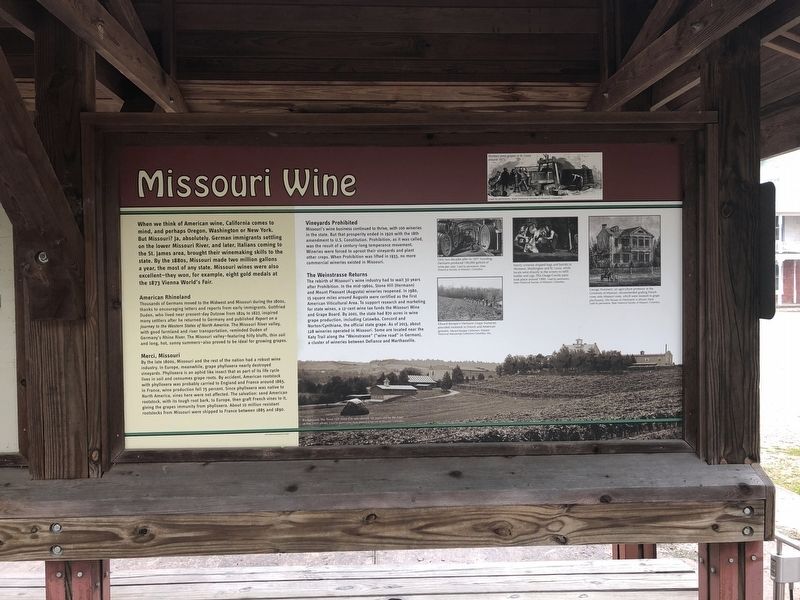Augusta in St. Charles County, Missouri — The American Midwest (Upper Plains)
Missouri Wine
When we think of American wine, California comes to mind, and perhaps Oregon, Washington or New York. But Missouri? Ja, absolutely. German immigrants settling on the lower Missouri River, and later, Italians coming to the St. James area, brought their winemaking skills to the state. By the 1880s, Missouri made two million gallons a year, the most of any state. Missouri wines were also excellent—they won, for example, eight gold medals at the 1873 Vienna World's Fair.
American Rhineland
Thousands of Germans moved to the Midwest and Missouri during the 1880s, thanks to encouraging letters and reports from early immigrants. Gottfried Duden, who lived near present-day Dutzow from 1824 to 1827, inspired many settlers after he returned to Germany and published Report on a Journey to the Western States of North America. The Missouri River valley with good farmland and river transportation, reminded Duden of Germany's Rhine River. The Missouri valley—featuring hilly bluffs, thin soil and long, hot, sunny summers—also proved to be ideal for growing grapes.
Merci, Missouri
By the late 1800s, Missouri and the rest of the nation had a robust wine industry. In Europe, meanwhile, grape phylloxera nearly destroyed vineyards. Phylloxera is an aphid like insect that as part of its life cycle lives in soil and consumes grape roots. By accident, American rootstock with phylloxera was probably carried to England and France around 1865. In France, wine production fell 75 percent. Since phylloxera was native to North America, vines were not affected. The salvation: send American rootstock, with its tough root bark, to Europe, then graft French vines to it, giving the grapes immunity from phylloxera. About 10 million resistant rootstocks from Missouri were shipped to France between 1885 and 1890.
Vineyards Prohibited
Missouri's wine business continued to thrive, with 100 wineries in the state. But that prosperity ended in 1920 with the 18th amendment to the U.S. Constitution. Prohibition, as it was called, was the result of a century-long temperance movement. Wineries were forced to uproot their vineyards and plant other crops. When Prohibition was lifted in 1933, no more commercial wineries existed in Missouri.
The Weinstrasse Returns
The rebirth of Missouri's wine industry had to wait 30 years after Prohibition. In the mid-1960s, Stone Hill (Hermann) and Mount Pleasant (Augusta) wineries reopened. In 1980, 15 square miles around Augusta were certified as the first American Viticultural Area. To support research and marketing for state wines, a 12-cent wine tax funds the Missouri Wine and Grape Board. By 2001, the state
[Captions:]
Workers press grapes in St. Louis around 1871.
Only two decades after its 1837 founding, Hermann produced 100,000 gallons of wine per year.
Family wineries shipped kegs and barrels to Hermann, Washington and St. Louis, while locals went directly to the winery to refill bottles and jugs. This Osage County party took place around 1900.
George Husmann, an agricultural professor at the University of Missouri, recommended grafting French vines onto Missouri roots, which were resistant to grape phylloxera. His house in Hermann is shown here.
Edward Kemper's Hermann Grape Nurseries provided rootstock to French and American growers.
Background: The Stone Hill Wine Co. was already 60 years old by the time of this 1910 photo.
Topics and series. This historical marker is listed in these topic lists: Agriculture • Horticulture & Forestry • Industry & Commerce • Waterways & Vessels. In addition, it is included in the Katy Trail State Park series list. A significant historical year for this entry is 1873.
Location. 38° 34.19′ N, 90° 52.885′ W. Marker is in Augusta, Missouri, in St. Charles County. Marker is on Public Street south of Water Street, on the left when traveling north. Touch for map. Marker is at or near this postal address: 5543 Water Street, Augusta MO 63332, United States of America. Touch for directions.
Other nearby markers. At least 8 other markers are within walking distance of this marker. Augusta to Matson (here, next to this marker); Augusta to Dutzow (here, next to this marker); August Sehrt House (approx. ¼ mile away); Augusta (approx. ¼ mile away); H. S. Clay House Bed & Breakfast and Guest Cottage (approx. ¼ mile away); Staudinger-Grumke House-Store (approx. 0.3 miles away); 5505 Locust Street (approx. 0.3 miles away); Dortmund (approx. 0.9 miles away). Touch for a list and map of all markers in Augusta.
Credits. This page was last revised on January 9, 2024. It was originally submitted on April 30, 2019, by Devry Becker Jones of Washington, District of Columbia. This page has been viewed 168 times since then and 16 times this year. Photos: 1, 2. submitted on April 30, 2019, by Devry Becker Jones of Washington, District of Columbia.

